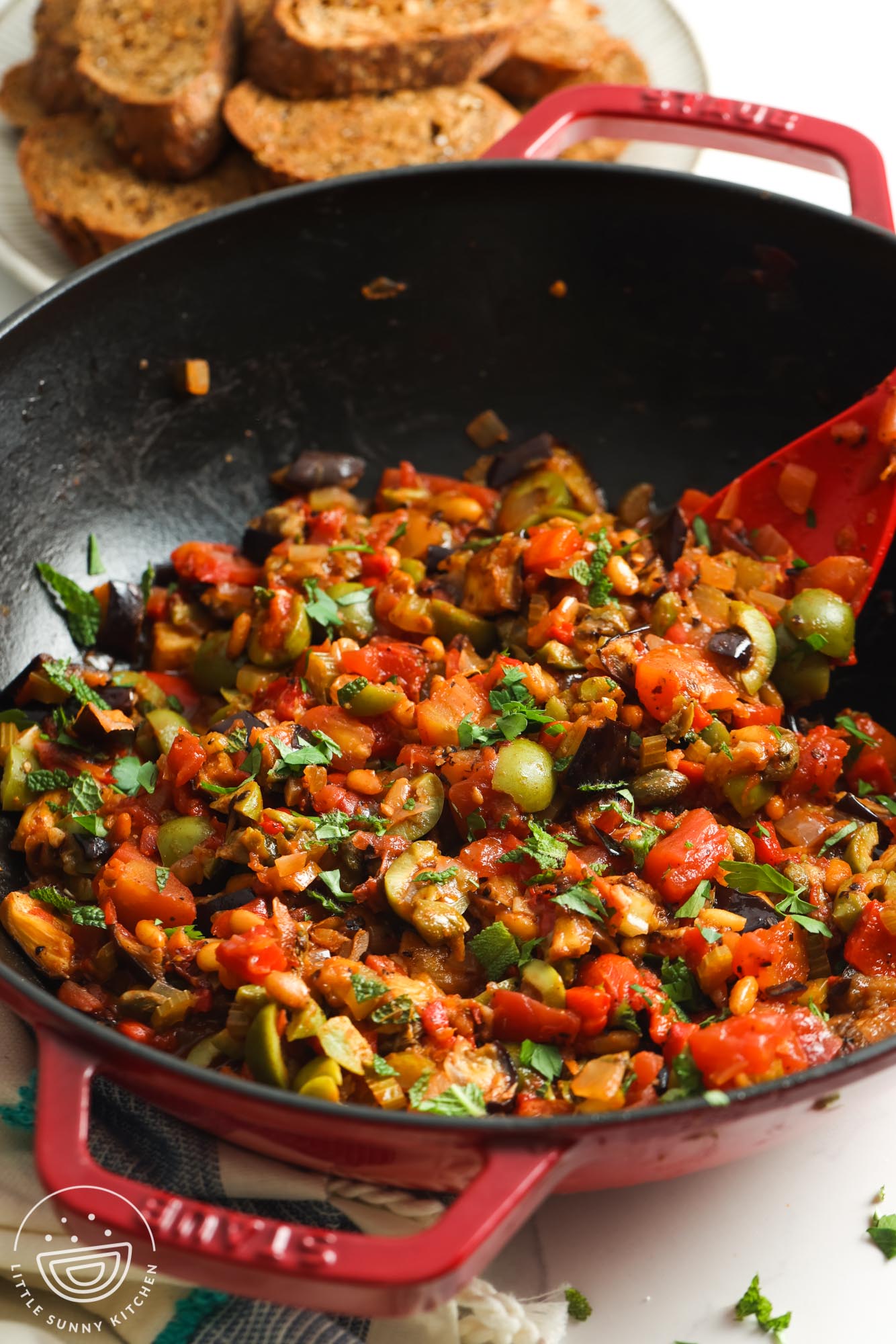

Caponata Siciliana
Traditional Caponata, a veggie-packed dish that every Sicilian home cook knows how to make, is a simple, summery salad/stew/spread that will take any meal to new heights.
I’ve developed this recipe as a streamlined version of the classic Sicilian caponata, skipping the traditional step of frying the eggplant and choosing to roast it instead to bring out all of it’s wonderful, rich, flavor.
Fresh vegetables, briny Italian olives such as Castelvetrono (Nocellara) olives, and capers are a must for this dish. To create a balanced “agrodolce” or sour-sweet flavor that Sicily is known for, we’re adding golden raisins and the perfect amount of honey.
I love this spread onto crusty bread or crostini. It’s also perfect with roasted or grilled salmon, steak, or chicken.
Caponata Ingredients
Here’s what you need to make this delicious eggplant caponata. There are quite a few ingredients, but they all play an equally important part in making this dish amazing.
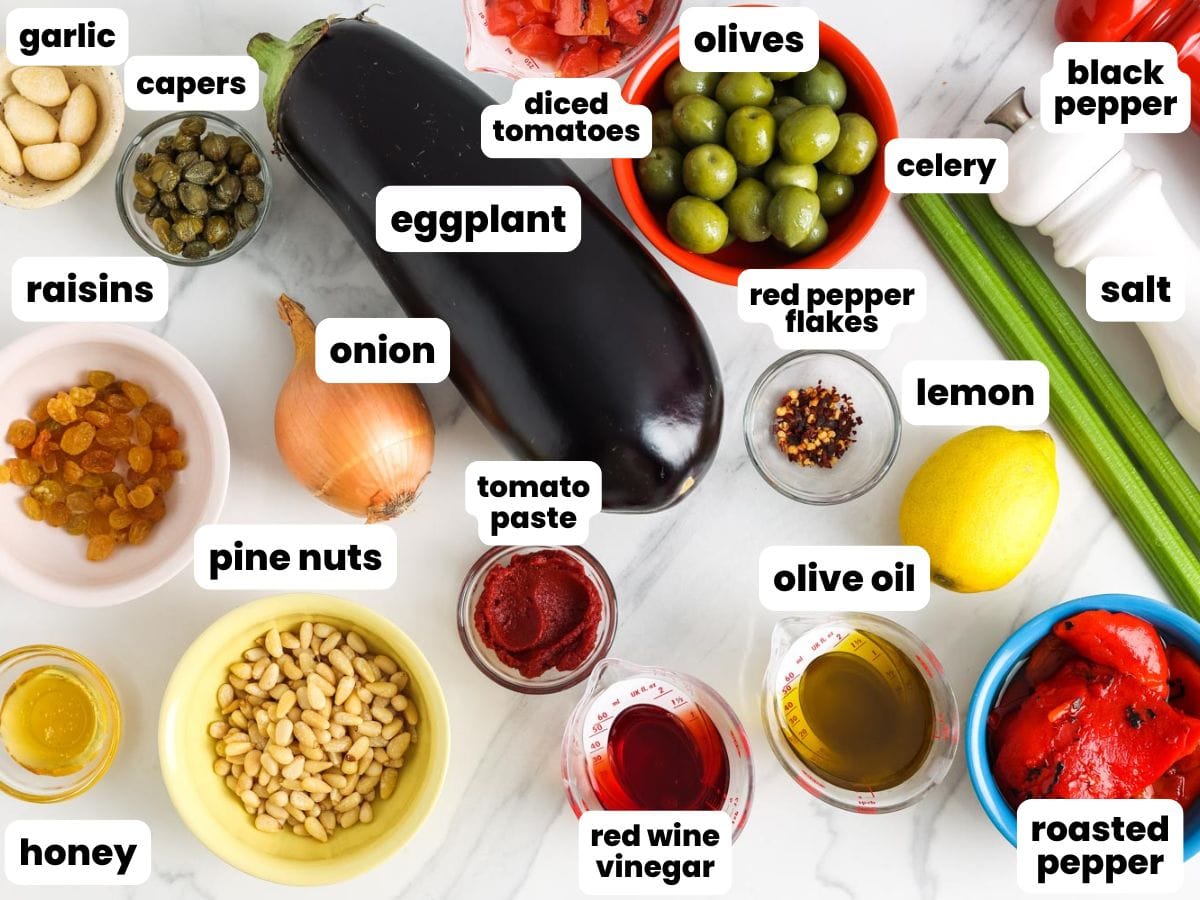
Complete list of ingredients and amounts can be found in the recipe card below.
- Eggplant: Choose a fresh, large Globe eggplant for this recipe. Dice it into cubes that are about 1 centimeter or a little less than half an inch. This will ensure that it roasts as quickly as possible in the oven.
- More Veggies: A yellow onion, 5 cloves of garlic, some celery, and diced tomatoes. Fire-roasted tomatoes are especially tasty in this recipe.
- Roasted Red Peppers: I love the sweet and savory flavor and the convenience of jarred roasted red peppers.
- Tomato Paste: A little goes a long way with this paste, which is concentrated tomato flavor in a can (or a tube). You won’t use the whole can, so try freezing the leftovers in 1 tablespoon portions to use for other recipes later.
- Capers and Green Olives: These give the caponata a wonderful briny, sour flavor note. Be sure to use Italian green olives, not the pimento stuffed ones that are common. You can generally find these in a jar in large grocery stores, or at your supermarket’s olive bar. If needed, remove the pits and chop the olives into smaller pieces.
- Honey and Golden Raisins: Sweetness will balance the sour and salty flavors. The raisins can be skipped if you really don’t like them, but I think they make this recipe extra delicious!
- Vinegar and Lemon: Red wine vinegar and freshly squeezed lemon juice add needed acidity and brightness, while a bit of lemon zest adds a special zing.
- Red Pepper Flakes: This recipe has ALL of the flavor notes, including a hint of spice.
- Toasted Pine Nuts: These are technically optional, but they do something very important in this recipe: they add a bit of crunch!
- Extra Virgin Olive Oil: I don’t suggest making any substitutions here. EVOO is exactly what would be used in Sicily to cook this dish.
Tip!
Worried your eggplant might be bitter? Some are, and some aren’t, and the only way to know is to taste a small piece before cooking. If you determine that it tastes bitter, lay out the diced pieces and sprinkle with kosher salt. Let sit for 15 minutes, then wipe away the moisture that comes out to remove the bitterness.
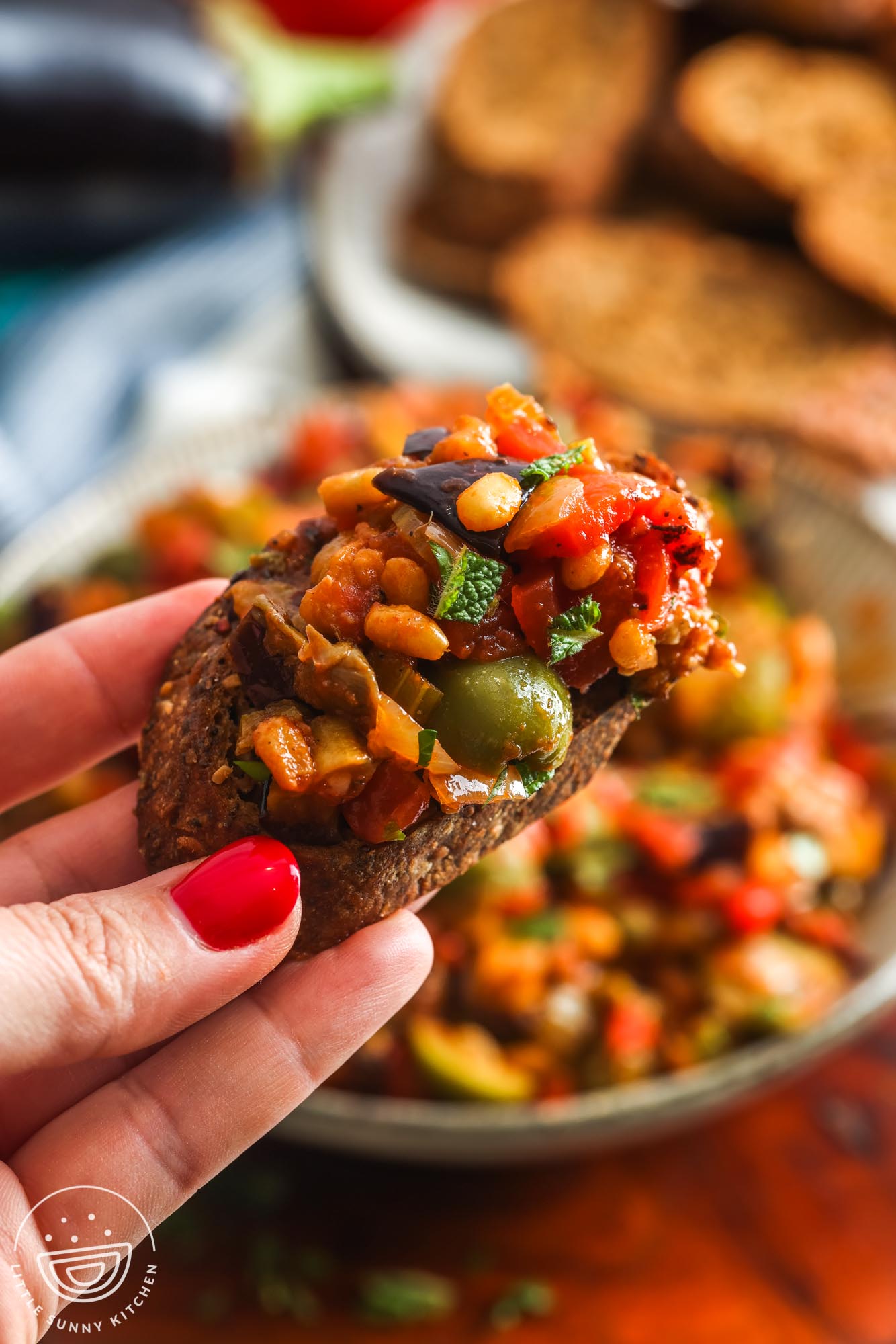
Recipe Tips
- Preparation: The French concept of mise en place is helpful for Italian recipes too! While your eggplant is roasting in the oven, you can use that time to chop and measure the rest of the ingredients so that they’re all ready to go into the pan when it’s their time.
- Resting: Give your caponata a bit of time to rest once you’re done cooking it. This time will allow it to cool down, but also allow the flavors of the dish to further develop and meld with each other.
- Simplify: If needed, you can leave out the raisins and pine nuts, but they’re really worth adding! Fresh herbs also give this dish the perfect finish, but if you don’t have them, it’s ok.
Storing Tips
Once cooled, you can store any leftovers in an airtight container in the refrigerator for up to 5 days.
Before serving, bring to room temperature, or heat gently in a skillet.
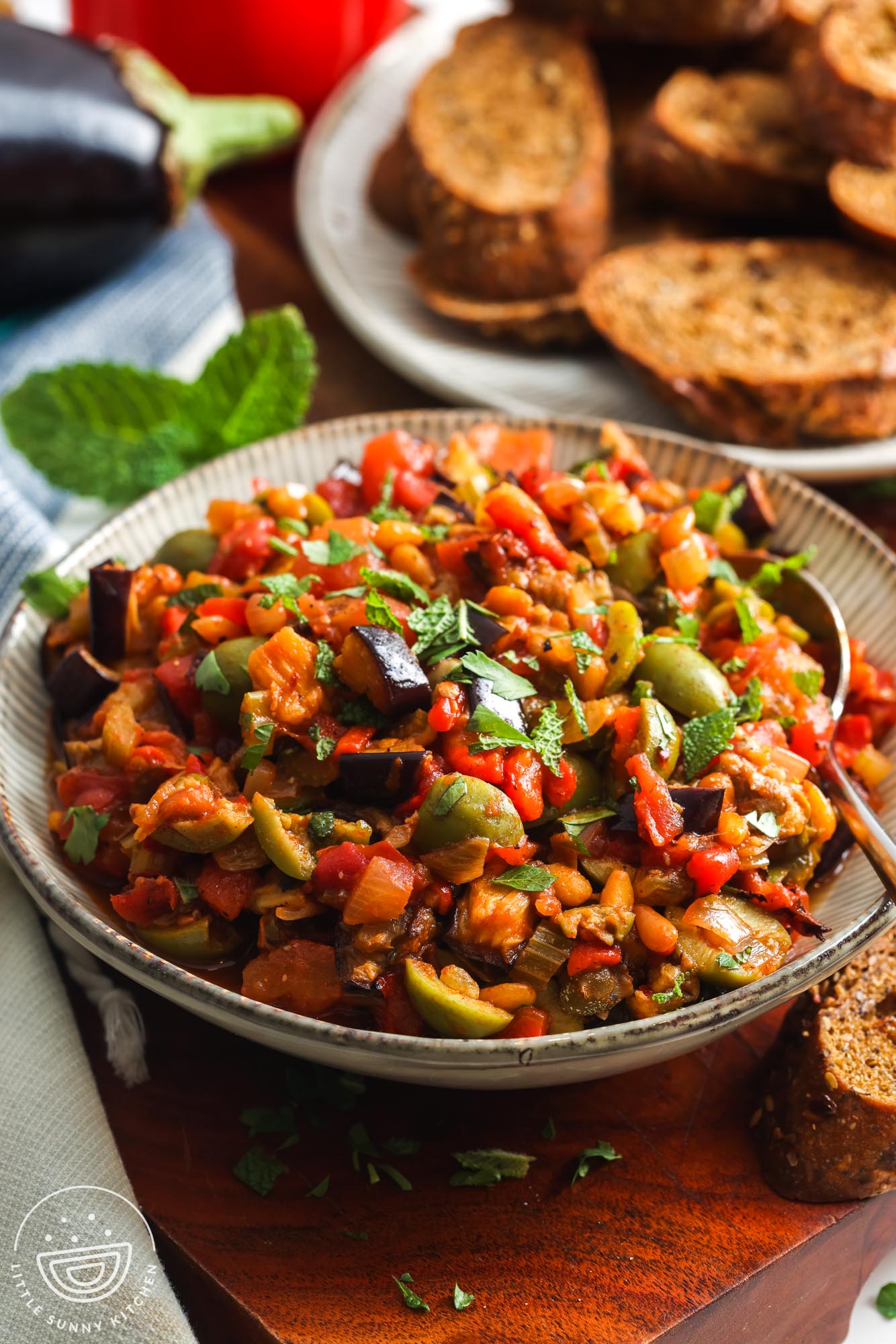
Did you make this? Be sure to leave a review below and tag me on Facebook, Instagram, or Pinterest!
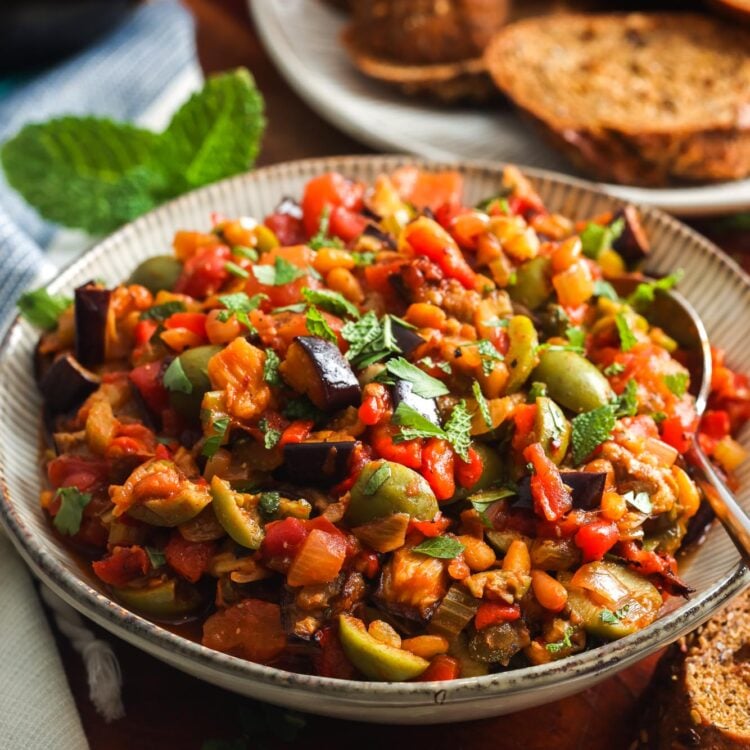
Sicilian Caponata with Pine Nuts and Green Olives
Equipment
- Rimmed baking sheet
Ingredients
- 1 large eggplant about 1 pound (450 g), cut into 1 cm cubes
- 4 tablespoons (60 ml) extra-virgin olive oil divided
- Salt and freshly ground black pepper to taste
- 1 medium yellow onion finely diced
- 2 small celery ribs diced
- 5 garlic cloves minced
- 2 tablespoons tomato paste
- 1 14.5 ounce can (400 g) diced fire roasted tomatoes or regular diced tomatoes
- 2 tablespoons (30 ml) red wine vinegar
- 1 teaspoon (7 g) honey
- 2 tablespoons capers rinsed if salt-packed
- ¾ cup (180 g) roasted red peppers (from a jar), diced
- ½ cup (70 g) green olives pitted and chopped or quartered
- 2 tablespoons golden raisins
- ¼ teaspoon red pepper flakes or to taste
- Zest of 1 lemon about 2 teaspoons
- 1 tablespoon (15 ml) freshly squeezed lemon juice
- ¼ cup (30 g) pine nuts
- Chopped fresh parsley and mint for garnish
Instructions
- Preheat the oven to 425°F (220°C).
- Toss the eggplant with 2 tablespoons of olive oil and season with salt and pepper.
- Spread the eggplant on a baking sheet and roast for 25-30 minutes, flipping halfway through.
- Heat the remaining 2 tablespoons of olive oil in a sauté pan over medium heat. Add the pine nuts and fry, stirring frequently, until the nuts are golden brown. Remove the pine nuts from the pan to a plate, leaving behind the oil.
- Add the onion and celery with a pinch of salt, and cook for 2-3 minutes until softened.
- Stir in the garlic and cook for 30 seconds until fragrant.
- Stir in the tomato paste and cook for 2 minutes, stirring frequently.
- Add the diced tomatoes, red wine vinegar, honey, capers, roasted peppers, green olives, golden raisins, and red pepper flakes. Let simmer for 3-4 minutes.
- Add the roasted eggplant and gently stir to combine. Remove from heat.
- Fold in the lemon zest, lemon juice, and toasted pine nuts.
- Taste and adjust seasoning as needed.
- Let rest for 15 minutes before serving. Garnish with fresh parsley and mint.
Notes:
- A simplified version of this recipe can be made without the raisins and pine nuts.
- Use Italian olives if at all possible. Castelvetrano olives are the traditional choice.
- Caponata can be served warm, chilled, or at room temperature.
- Store leftovers in an airtight container in the fridge for up to 5 days.
Nutrition Information
This website provides approximate nutrition information for convenience and as a courtesy only. Nutrition data is gathered primarily from the USDA Food Composition Database, whenever available, or otherwise other online calculators.
© Little Sunny Kitchen
How to Serve Caponata
- I really enjoy serving this salad as a spread. It’s perfect on crusty bread or sturdy crackers as an appetizer.
- Try it on toast, topped with a poached or fried egg for a fabulous breakfast or brunch meal.
- For dinner, use your homemade caponata as a side dish along with roasted or grilled fish, steaks, or chicken.
- Use caponata as a pasta sauce! Heat the caponata in a skillet and toss in freshly boiled pasta and a bit of the pasta water to pull everything together. Add freshly grated Parmesan cheese before serving. Yum!
- Looking for the perfect dessert recipe? Try my reader favorite Tiramisu, or homemade Italian Cannoli.

Caponata Recipe FAQs
What is the difference between Ratatouille and Caponata?
Both of these dishes are made with eggplant and tomato, but the flavors are much different. Ratatouille is a summer vegetable stew, usually made with zucchini, peppers, tomato, and eggplant.
In contrast, Caponata, while also made with summer veggies, is less of a stew and more of a cooked salad, with veggies that have more texture and additions like olives, capers, and pine nuts that offer much more complex flavor.
Can I make Caponata with Kalamata Olives?
While you technically could make a version of caponata with Kalamata olives, I don’t recommend it. Kalamata olives and other black olives are a little too bitter and salty for this recipe. Green olives have a brighter flavor that works better.
Should I serve Caponata chilled or warm?
It can be served either way! I like this dish best when it’s at room temperature. I suggest letting the cooked mixture rest for at least 15 minutes before serving. You can also store caponata in the fridge and let it sit out on the counter for a bit to lose its chill.
Is Sicilian Food Different than Italian Food?
While Sicily is part of the country of Italy, it is an island that sits slightly removed from the mainland in the Mediterranean Sea. Sicily has its own distinct culture and a specific regional cuisine that incorporates some things from Italian cooking and others from the roots of the island’s original settlers. In Sicily, you’ll find dishes inspired by Greek, Spanish, and Maghreb cuisines.
Roasted eggplant has never been more exciting than in this flavorful Sicilian Caponata Recipe! Save this recipe – it will come in handy over the summer when fresh vegetables are abundant.
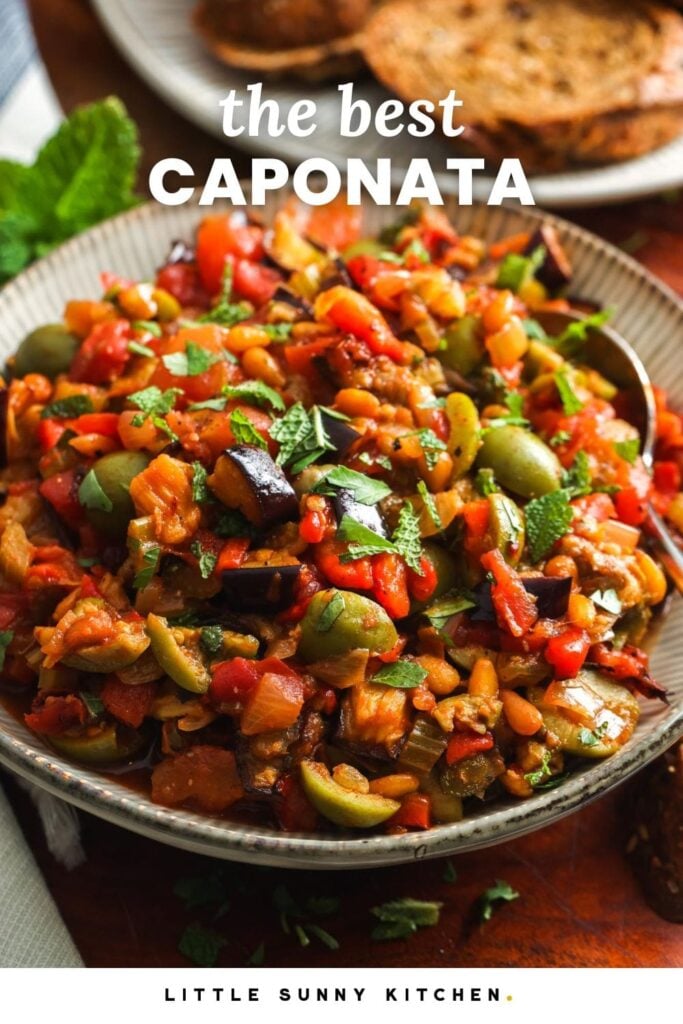

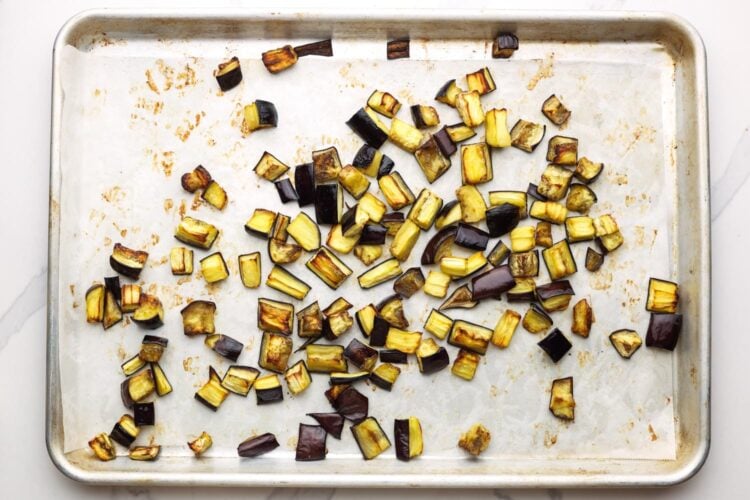
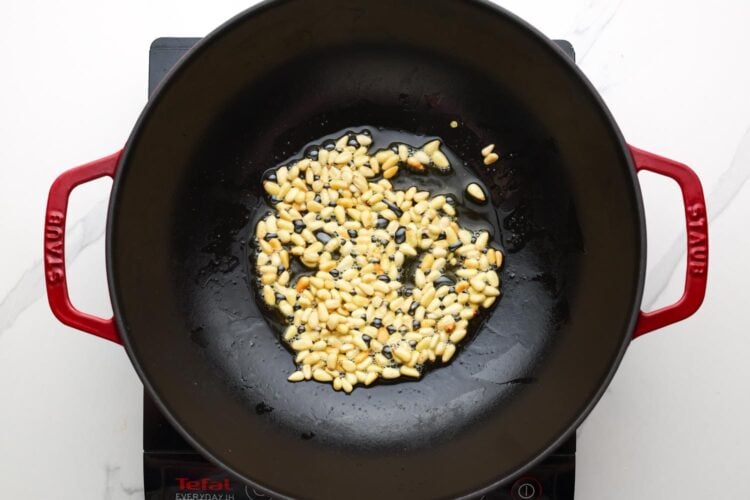
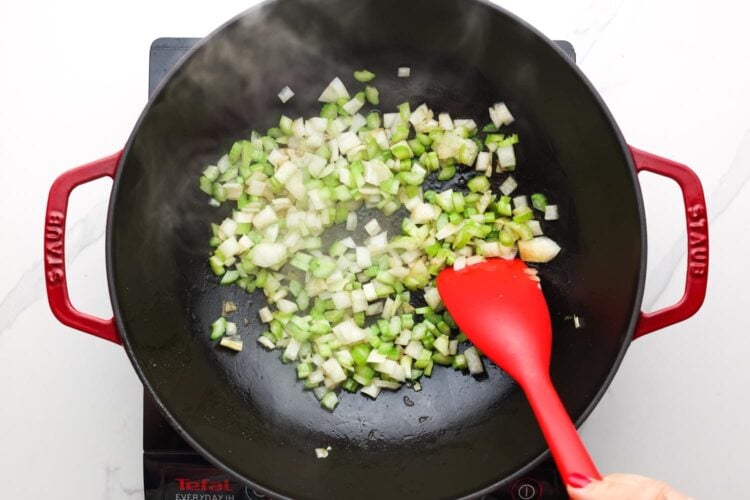
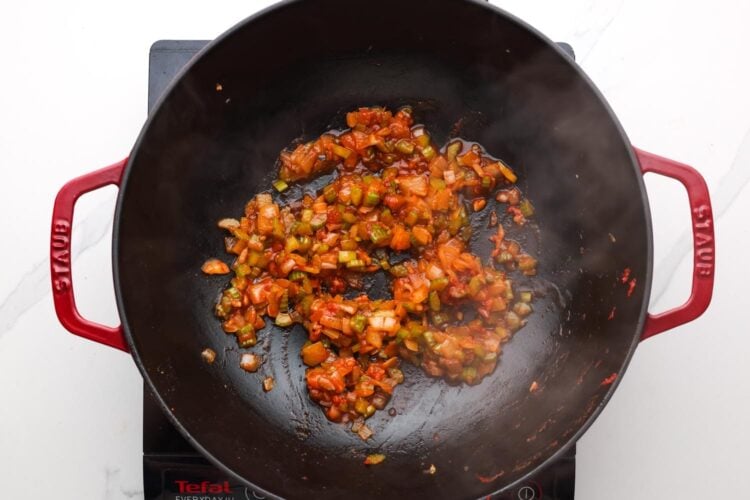
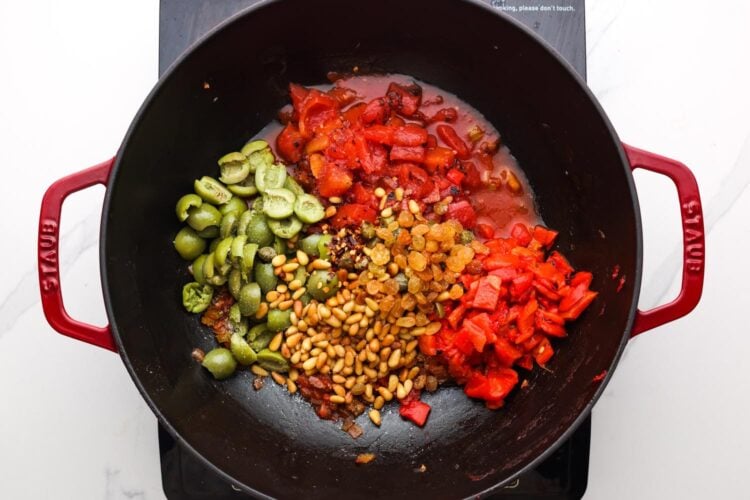
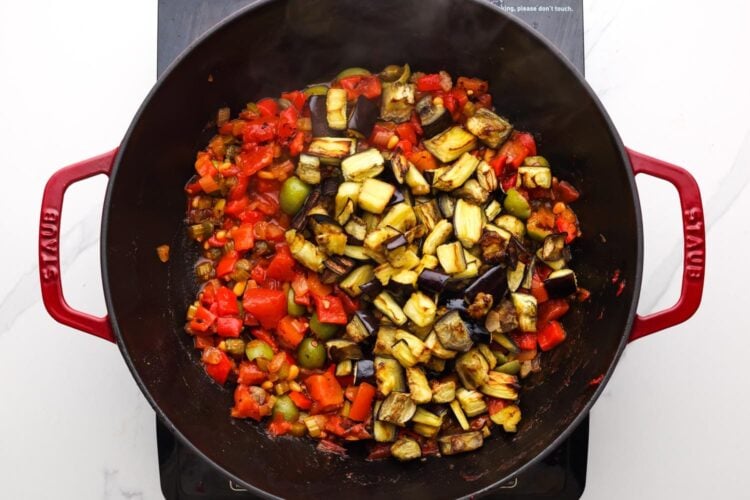
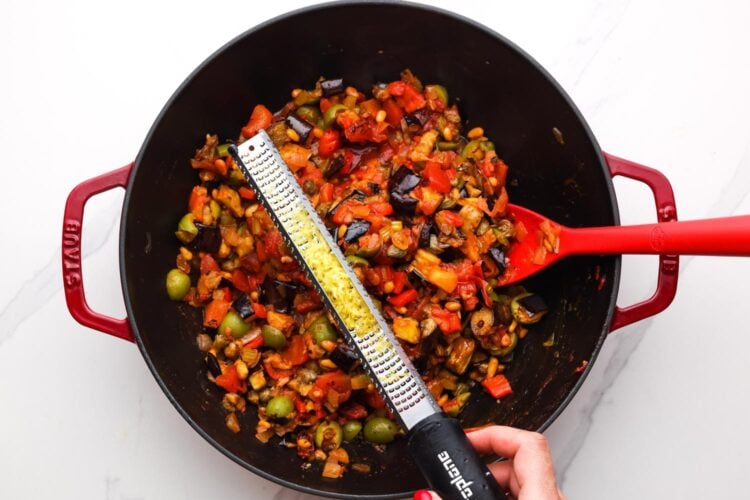
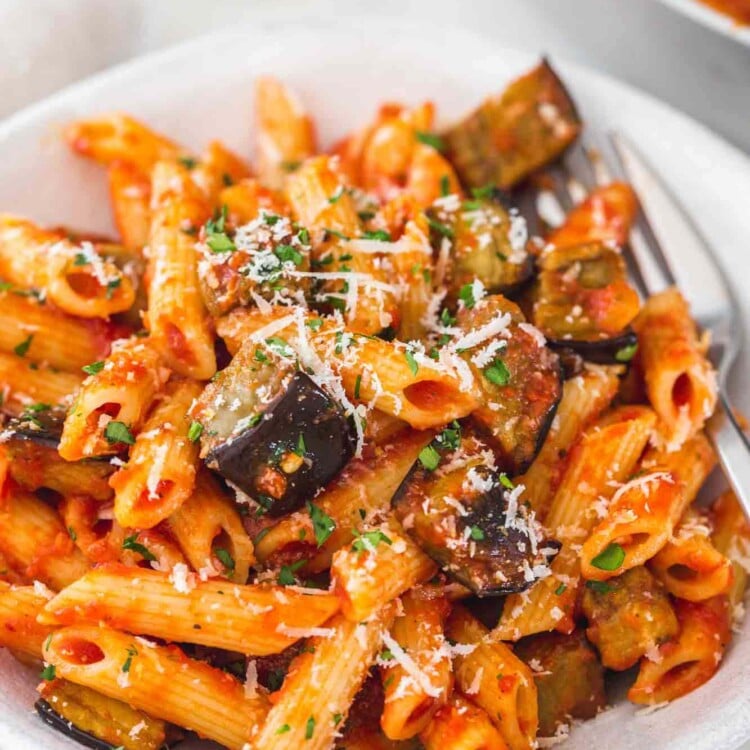

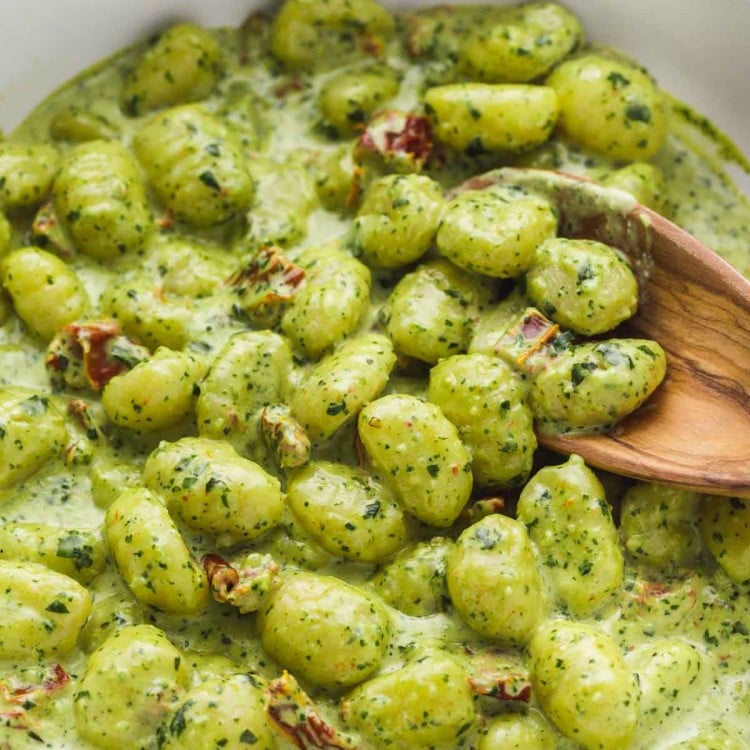
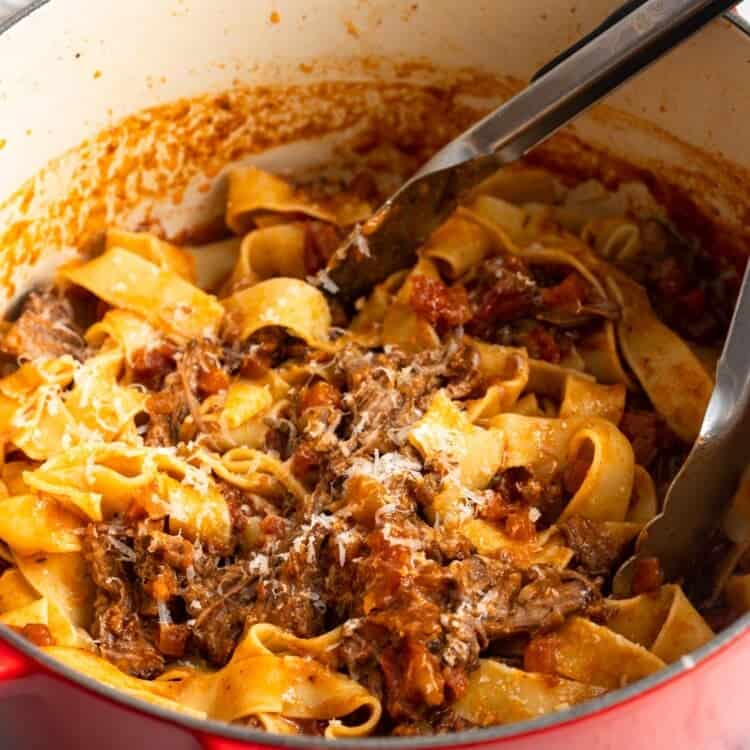

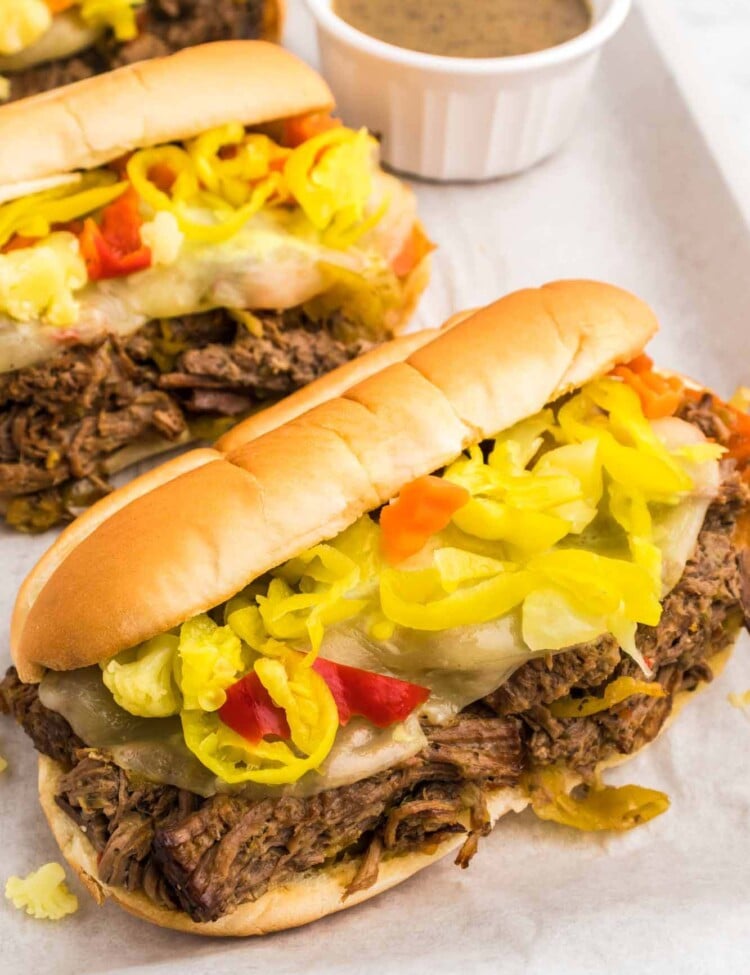

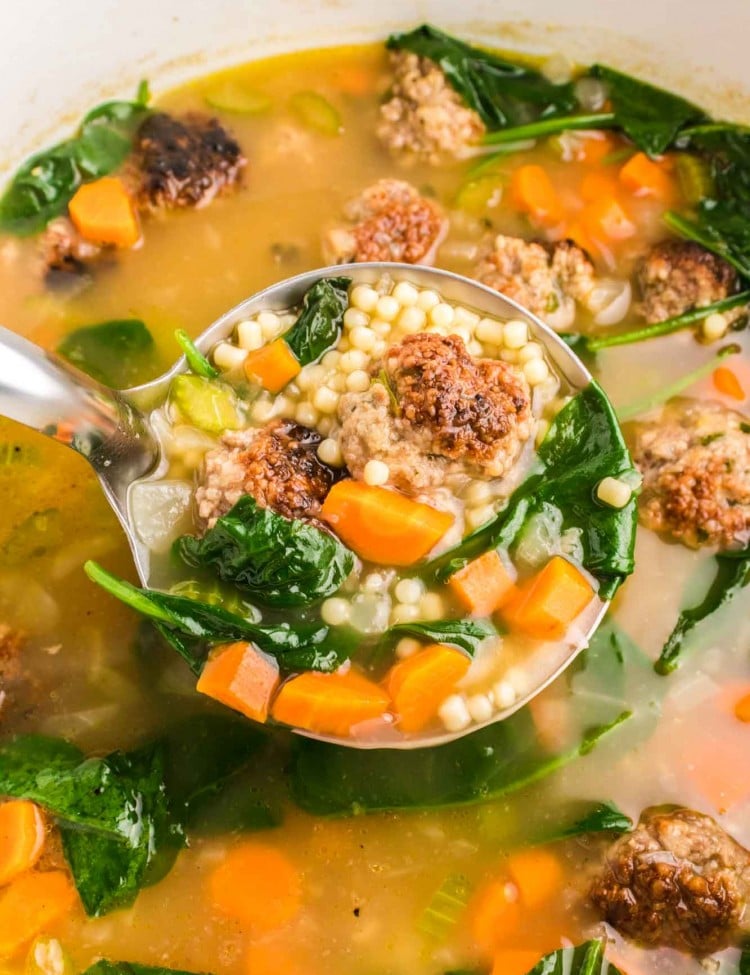

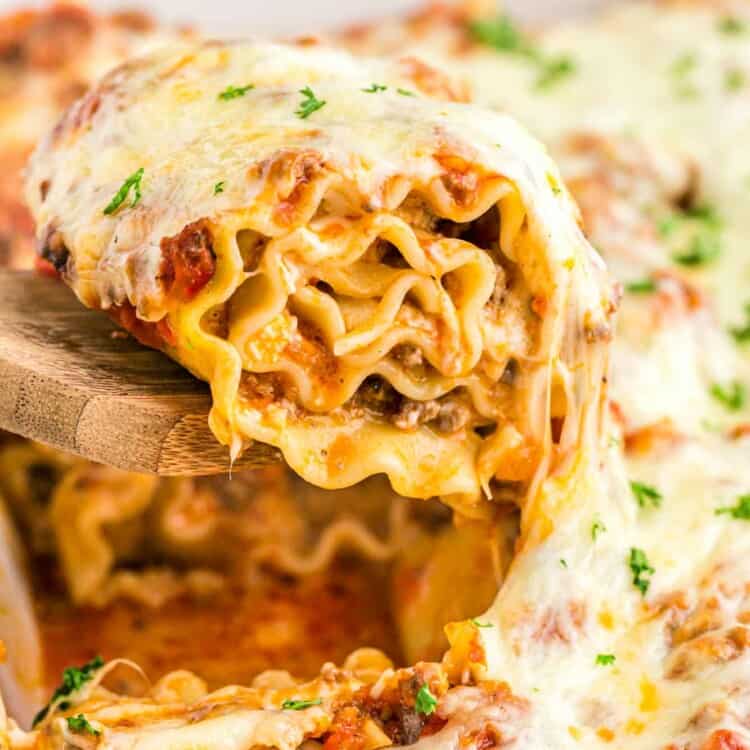
Leave a Review!